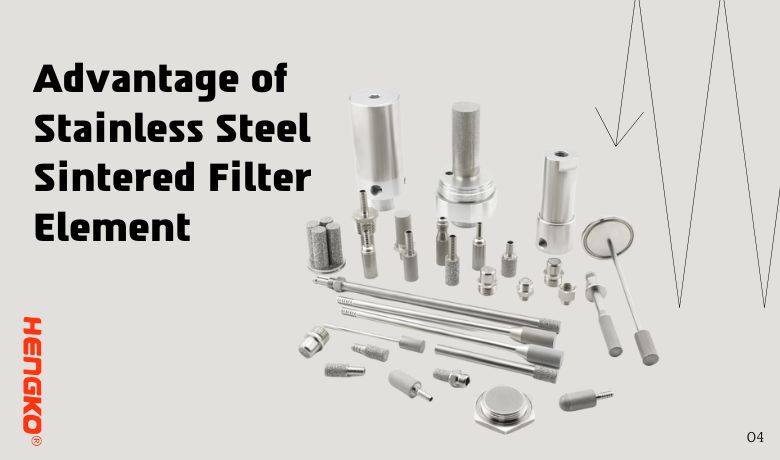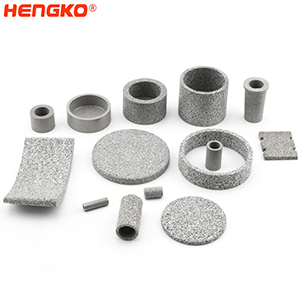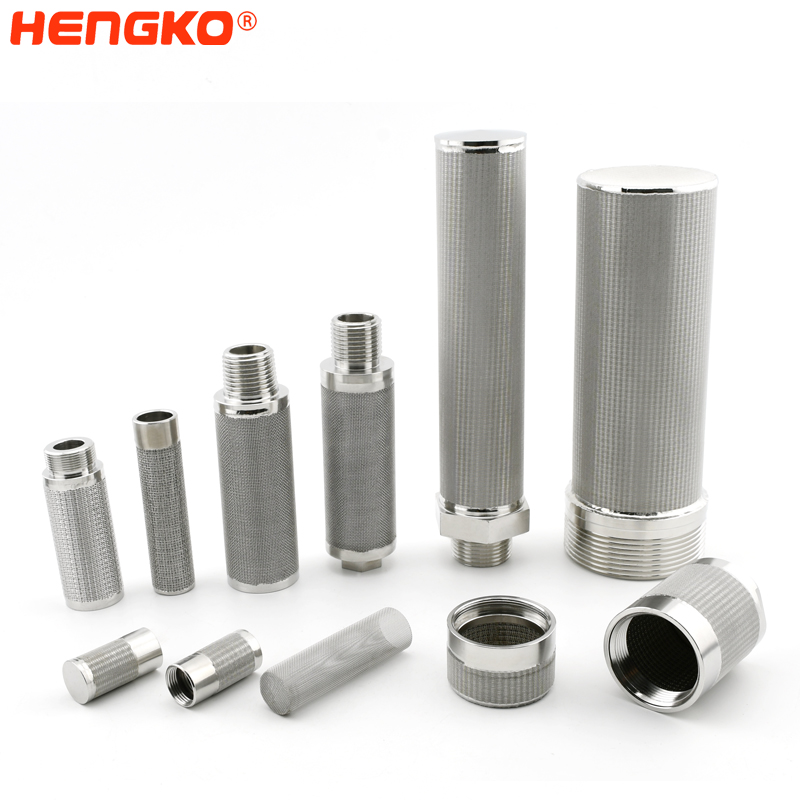
Do You Know What is the Advantage of Stainless Steel Sintered Filter Element ?
As a vital sintered metal filter elements for industry porous media company - HENGKO, sintered porous stainless steel filters has advantage of corrosion resistance, high temperature resistance, high strength, high compression resistance and good reproducibility that widely used in filtration, noise reduction, noise reduction, uniform gas, high temperature steam filtration etc. Compared sintered wire mesh filter, powder filter element has better pollution absorption capacity. Its working principle is deep filtration, and small pore size can filter particulate matter more thoroughly.
The pore size of HENGKO sintered metal filters is 0.2um min. You can OEM any Pore Size of the metal filter, Such fine filter can achieve ultrafiltration and precision filtration in pharmaceutical, biological, vaccine production, life science research, clean room and other application scenarios with high purification and filtration requirements.
TOP10 Advantage of Stainless Steel Sintered Filter Elements
The Stainless Steel Sintered Filter Element is a marvel in the filtration industry, offering unparalleled benefits that span across various applications. If you're considering its utility, here are the top 10 advantages of using this filtration solution and how you can harness them to enhance your product quality and production efficiency.
1. High Strength and Durability
* Feature: The sintering process bonds stainless steel particles together, creating an extremely robust and durable structure.
* Utilization: This ensures a longer service life, reducing the frequency of filter replacements and maintenance downtime.
2. High Temperature Resistance
* Feature: Stainless steel can withstand high temperatures without deforming or losing its filtration capabilities.
* Utilization: Ideal for applications where high temperatures are prevalent, ensuring consistent performance.
3. Corrosion Resistance
* Feature: The inherent properties of stainless steel make it resistant to corrosion, even in aggressive environments.
* Utilization: Use it in settings with chemicals or where corrosion is a concern, thereby safeguarding the filter's integrity and reducing the need for frequent replacements.
4. Fine and Precise Filtration
* Feature: The sintering process allows for precision in pore size, enabling fine filtration.
* Utilization: Achieve clarity in output fluids and protect sensitive downstream equipment from contaminants.
5. Backwashable and Cleanable
* Feature: Unlike disposable filters, sintered filters can be backwashed and cleaned, removing accumulated contaminants.
* Utilization: Increase operational efficiency by reducing waste and cost associated with frequent filter replacements.
6. Uniform Pore Size Distribution
* Feature: The sintering process ensures a consistent and uniform pore size across the filter surface.
* Utilization: Benefit from consistent filtration quality and avoid "weak spots" in the filtration process.
7. Versatility in Design and Application
* Feature: They can be fashioned into various shapes and sizes, catering to specific needs.
* Utilization: Tailor your filtration solution to the exact requirements of your application, whether it's for liquid, gas, or a particular flow rate.
8. Enhanced Structural Stability
* Feature: The mechanical strength of sintered stainless steel means it's less prone to breaking or fracturing.
* Utilization: Ensure safety in high-pressure applications and reduce the risk of operational hiccups.
9. Environmentally Friendly
* Feature: Given their durability and reusability, these filter elements contribute less waste over their lifespan.
* Utilization: Support sustainability goals, reduce environmental footprint, and potentially gain favor in markets where eco-friendliness is a key selling point.
10. Cost-Efficient in the Long Run
* Feature: Despite initial costs, the longevity and reusability of stainless steel sintered filters offer savings in the long-term.
* Utilization: Look beyond immediate expenses and consider the cost benefits over the filter's operational lifespan, factoring in reduced maintenance, replacement, and waste disposal costs.
Incorporating the Stainless Steel Sintered Filter Element into your operations, with a focus on these advantages, can elevate the quality of your output and the efficiency of your production processes. Harness its strengths and let it be the workhorse that powers your filtration needs to new heights.
Stainless Steel Sintered Filter Feature
1. 316L Stainless Steel Sintered Filter Element is Surface Filtration
2. Stainless Steel Filter Element is Good for Backwash
3. Sintered Stainless Steel Filter Element has Uniform Pore Size Distribution
4. High Mechanical Strength
5. High Temperature Resistance
6. High Filter Efficiency
7. High Corrosion Resistance
8. Washable and Cleanable
9. Reusable
10.Long service life
What You Can Do If Have Special Requirements for the Stainless Steel Sintered Filter Element ?
If you want large flow, you can choose products with high precision sintering mesh, large flow and good filtration effect. HENGKO sintered mesh filter element is widely used in the filtration and purification of polymer melts in the food, beverage, and chemical industries, the filtration of various high temperature, corrosive liquids, and the screening of large particles such as sediment.
If you have requirement of precise micro filtration rather than flow, you can choose the porous metal filters products. You can choose the suitable product according to your requirement. With more than 20+ years of experience in the filtration industry to provide professional filtration solutions, we service customers in more than 100 countries around the world with high standards and strict inspection procedures, creating more than 30,000 engineering solutions.
Choosing and OEM a Stainless Steel Sintered Filter Element Based on Its Advantages ?
To fully harness the benefits of Stainless Steel Sintered Filter Elements, it's crucial to select the right type and customize it appropriately for your specific filtration system. Here's a step-by-step guide on how to go about it:
1. Define Your Filtration Needs
Purpose: Determine whether you're filtering gases, liquids, or both.
Particle Size: Identify the smallest particle size you need to filter out. This will help in determining the pore size of the filter.
Flow Rate: Estimate the volume of material to be filtered within a given time.
Temperature and Pressure: Note the operating conditions—some applications may require filters that can withstand high temperatures or pressures.
Chemical Compatibility: Make a list of chemicals that the filter will be exposed to. This ensures you select a filter that won't corrode or degrade.
2. Selection of the Filter Based on the Advantages:
If strength and durability are paramount, ensure the filter has a solid sintered construction.
For high-temperature applications, ensure the filter's specific stainless steel alloy is rated for such temperatures.
In corrosive environments, opt for stainless steel grades known for superior corrosion resistance.
For precise filtration, focus on filters with uniform and well-defined pore sizes.
3. Engage with an OEM (Original Equipment Manufacturer):
Research: Look for manufacturers with a proven track record in producing sintered stainless steel filters.
Consultation: Share your filtration requirements with the OEM. Their expertise will guide you towards the best product or customization options.
Prototyping: For unique requirements, the OEM might produce a prototype. This allows you to test and validate the filter before mass production.
4. Custom Design:
Shape and Size: Specify the desired shape (disc, tube, cone, etc.) and dimensions.
Layering: Depending on your requirements, multi-layered sintered filters can be produced, each layer having different pore sizes or functionalities.
End Fittings: If your system requires special connectors or end caps, specify this to the OEM.
5. Quality Control:
Ensure the OEM follows strict quality control procedures. This guarantees the filters meet the specified requirements and function as intended.
Consider asking for certifications or testing reports as proof of quality.
6. Order and Delivery:
Once satisfied with the prototype or the product specifications, place your order. Ensure you understand the lead times.
Discuss packaging and shipping options. For fragile designs, consider investing in robust packaging.
7. Installation and Integration:
On receiving the filters, integrate them into your filtration system.
For first-time use, follow OEM guidelines on pre-use cleaning or conditioning.
8. Maintenance and Replacement:
Schedule regular inspections and cleaning, based on the manufacturer's guidelines and your operating conditions.
Track the filter's performance over time. If efficiency drops or the filter shows signs of wear, consider replacements.
By meticulously following these steps and working closely with a reputable OEM, you can harness the full potential of Stainless Steel Sintered Filter Elements in your filtration system.
So if have any questions and OEM Sintered Filter, pleas feel free to contact us
by email ka@hengko.com, we will try our best supply you with best filtration solution for your device and projects.
Post time: Nov-10-2021







